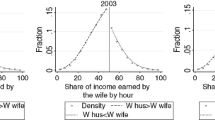Abstract
Empirical research has consistently shown that, on average, men are paid higher wages than women. Moreover, men enjoy more leisure time than women. We develop a noncooperative model of the private provision of family public goods to analyze whether the wage gap and the leisure gap are related. Simultaneous and sequential decision-making structures within a couple lead to different empirical hypotheses. Our estimates based on the German Socio-Economic Panel data show that husbands enjoy, other things equal, more leisure time than their wives. This advantage can be explained if the husband is the Stackelberg leader in a sequential private provision game.
Similar content being viewed by others
References
Apps PF (2003) Gender, time use, and models of the household. Discussion Paper No. 796, IZA, Bonn.
Apps PF, Rees R (1996) Labour supply, household production and intra-family welfare distribution. J Public Econ 60(2):199–219
Becker GS (1965) A theory of the allocation of time. Econ J 75:493–517
Becker GS (1976) The economic approach to human behavior. University of Chicago Press, Chicago
Becker GS (1985) Human capital, effort, and the sexual division of labor. J Labor Econ 3(1):33–58
Bergstrom T, Blume L, Varian H (1986) On the private provision of public goods. J Public Econ 29(1):25–49
Bolin K (1996) An economic analysis of marriage and divorce. Lund Econ Stud 62
Brines J (1994) Economic dependency, gender, and the division of labor at home. Am J Sociol 100(3):652–688
Buchholz W, Konrad KA, Lommerud KE (1997) Stackelberg leadership and transfers in private provision of public goods. Rev Econ Des 3(1):29–43
Chen Z, Woolley F (2001) A Cournot–Nash model of family decision making. Econ J 111:722–748
Cornes RC, Sandler T (1984) Easy riders, joint production, and public goods. Econ J 94:580–598
Daly K (1996) Families and time: keeping pace in a hurried culture. Sage Publications, Thousand Oaks
Elul R, Silva-Reus J, Volij O (2002) Will you marry me? A perspective on the gender gap. J Econ Behav Organ 49(4):549–572
European Commission (2003) Employment in Europe 2003. Office for Official Publications of the European Communities, Luxembourg
Eurostat (2004) How Europeans spend their time — everyday life of women and men — data 1998–2002. Office for Official Publications of the European Communities, Luxembourg
Frank RH (1978) Why women earn less: the theory and estimation of differential overqualification. Am Econ Rev 68(3):360–373
Greenstein TN (2000) Economic dependence, gender, and the division of labor in the home: a replication and extension. J Marriage Fam 62(2):322–335
Hallberg D (2003) Synchronous leisure, jointness and household labor supply. Labour Econ 10(2):185–203
Hochschild A (1989) The second shift. Viking, New York
Huber J, Spitze G (1983) Sex stratification: children, housework and jobs. Academic, New York
Jenkins S, Osberg L (2003) Nobody to play with? The implications of leisure coordination. Discussion Paper No. 850, IZA, Bonn
Juster FT, Stafford FP (1991) The allocation of time: empirical findings, behavioral models, and problems of measurement. J Econ Lit 29(1):417–522
Kimball MS (1990) Precautionary saving in the small and in the large. Econometrica 58:53–73
Konrad KA, Lommerud KE (1995) Family policy with non-cooperative families. Scand J Econ 97(4):581–601
Konrad KA, Lommerud KE (2000) The bargaining family revisited. Can J Econ 33(2):471–487
Kooreman P, Kapteyn A (1990) On the empirical implementation of some game theoretic models of household labor supply. J Hum Resour 25(4):584–598
Leuthold J (1968) An empirical study of formula income transfers and the work decisions of the poor. J Hum Resour 3:312–323
Lommerud KE (1997) Battles of the sexes: non-cooperative games in the theory of the family. In: Jonung C, Persson I (eds) Economics of the family and family policies (Routledge Research in Gender and Society, 1). Routledge, London and New York, pp 44–62
Lundberg S, Pollak RA (1993) Separate spheres bargaining and the marriage market. J Polit Econ 101(6):988–1010
Manser M, Brown M (1980) Marriage and household decision making: a bargaining analysis. Int Econ Rev 21(1):31–44
McElroy MB, Horney MJ (1981) Nash bargained household decisions. Int Econ Rev 22(2):333–349
O’Neill J (2003) The gender gap in wages, circa 2000. Am Econ Rev 93(2):309–314
Ott N (1992) Intrafamily bargaining and household decisions. Springer, Berlin Heidelberg New York
Ott N (1998) Der familienökonomische Ansatz von Gary S. Becker. In: Pies I, Leschke M (eds) Gary Beckers ökonomischer Imperialismus (Konzepte der Gesellschaftstheorie, 4). Mohr Siebeck, Tübingen, pp 63–90
Spieß CK, Büchel F, Frick JR (2002) Kinderbetreuung in West- und Ostdeutschland: Sozioökonomischer Hintergrund entscheidend. DIW Berlin Wochenbericht Nr. 31/02
Vagstad S (2001) On private incentives to acquire household production skills. J Popul Econ 14(2):301–312
Weichselbaumer D, Winter-Ebmer R (2005) A meta-analysis of the international gender wage gap. J Econ Surv 19(3):479–511
Author information
Authors and Affiliations
Corresponding author
Additional information
Responsible editor: Deborah Cobb-Clark
Rights and permissions
About this article
Cite this article
Beblo, M., Robledo, J.R. The wage gap and the leisure gap for double-earner couples. J Popul Econ 21, 281–304 (2008). https://doi.org/10.1007/s00148-006-0132-5
Received:
Accepted:
Published:
Issue Date:
DOI: https://doi.org/10.1007/s00148-006-0132-5




